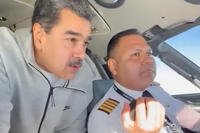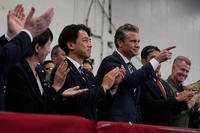An airman's remains were recovered from the wreckage of an Air Force Osprey that crashed this week off the coast of Japan and the seven other crew members aboard were still unaccounted for on Friday, according to the latest update from the service.
Air Force Special Operations Command said in a statement that "one set of remains has been recovered" and the other airmen on the Osprey were "duty status-whereabouts unknown," a term used by the military when the status of missing service members, including those lost at sea, cannot be confirmed.
Search-and-rescue efforts along the southwestern coast of Japan that began Wednesday were still ongoing Friday, the command said, and have included large numbers of U.S. military personnel and Japanese government assistance.
The deceased airman was identified as Staff Sgt. Jacob Galliher, a native of Pittsfield, Massachusetts, according to a press release from his congressman, Rep. Richard Neal, D-Mass.
"Staff Sgt. Galliher represented our nation's best, enlisting in the Air Force right out of high school and committing himself to serving his country," Neal wrote. "My thoughts and prayers are with his family, especially his mother, father, wife and two sons."
A Facebook post from his local police department said Galliher was a 2017 high school graduate and leaves behind a wife and two young boys, one who is 2 years old and one who is six weeks old.
"To Jacob's family, friends, our community is [mourning] with you, and also the families of the other seven who have yet to be located," the Pittsfield Police Department wrote.
The other crew members of the Osprey who were still missing were not identified Friday.
The Pacific Air Forces, U.S. Pacific fleet, U.S. Marine Corps Pacific, Special Operations Command Pacific, the 353rd Special Operations Wing and the 18th Wing out of Kadena Air Base on Okinawa, as well as the 1st Special Forces Group, all contributed assets to the search.
The Japan Coast Guard, Japanese Self-Defense Forces and fishermen in the area were also helping. The Japanese were the first to report a death from the crash on Wednesday.
A Wednesday statement from Air Force Special Operations Command said the CV-22B Osprey, assigned to the 353rd Special Operations Wing, was on a training mission off the shore of Yakushima Island -- between the Japanese mainland and Okinawa -- with the eight airmen aboard when it went down in the ocean.
Sabrina Singh, a Pentagon spokeswoman, said in a statement Friday that the Air Force unit that owned the Osprey had grounded its other Ospreys and additional inspections of the U.S. military's aircraft based in Japan were underway.
"The unit of the CV-22 that had the accident is not conducting flight operations," Singh said in an email Friday. "All V-22 Ospreys in Japan operate only after undergoing thorough maintenance and safety checks."
Japanese officials voiced public concerns about the dual-rotor aircraft, which can fly like helicopters or airplanes, following the incident and called for their own country's fleet of Ospreys to be grounded amid investigations into Wednesday's crash. The Japanese Self-Defense Forces have 14 Ospreys in their fleet.
Japanese Chief Cabinet Secretary Hirokazu Matsuno also told reporters the country asked the U.S. to ground its Ospreys in Japan, unless they're being utilized for the search-and-rescue efforts, until "their safety is confirmed," The Associated Press reported.
Singh told reporters during a Pentagon press briefing Thursday that the department was not tracking an official request from the Japanese government. On Friday, she added that the Pentagon is keeping the Japanese government in the loop regarding its inspections.
"We have already started sharing information about the accident with our Japanese partners, and have pledged to continue to do so in a timely and transparent manner," Singh said in an emailed statement.
Military.com has extensively reported on safety issues -- including a mechanical clutch problem -- and recent deadly crashes of Air Force and Marine Corps Osprey aircraft.
On Sept. 14, within just two hours of each other, two Marine V-22 Ospreys in Japan diverted due to "cockpit caution indications" in the aircraft while flying near where the Air Force Osprey crashed this week.
Those Marine Corps aircraft landed safely, the service said at that time, and no injuries or fatalities were reported by the service.
The latest deadly crash occurred with a Marine Corps Osprey in Australia in August, claiming the lives of three Marines. Another Marine Corps Osprey went down last year in Southern California, killing five Marines. Investigation findings released in July showed the cause of that crash in California was a hard clutch engagement, or HCE, a mechanical issue that has plagued the aircraft for more than a decade.
It's not yet clear what caused Wednesday's crash off Yakushima Island.
Editor's note: This story was updated with the identity of the airman whose remains were recovered from the crash.
-- Konstantin Toropin contributed to this report.
-- Thomas Novelly can be reached at thomas.novelly@military.com. Follow him on X @TomNovelly.
Related: Fate of 8 Airmen Still Unknown as Search Mission Continues After Osprey Crashes Off Japan Coast












